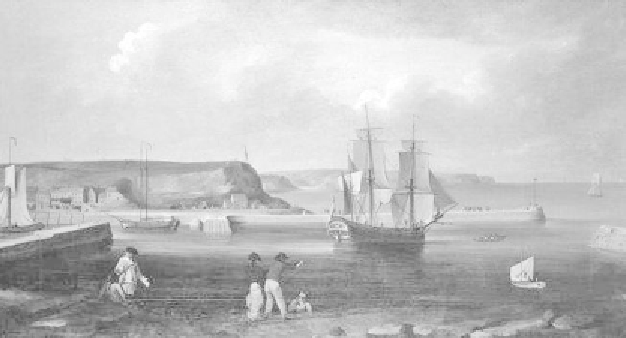Global Positioning System Reference
In-Depth Information
FIGURE 7.4.
HMS
Endeavour
, painted in 1790 by Thomas Luny. The ship is depicted as
she was in 1768, before Cook renamed her. She was extensively refitted and
strengthened for his first voyage.
Wikipedia.
while he was in the merchant marine, not the Royal Navy. Despite these
perceived shortcomings, he was appointed leader of the expedition be-
cause of his well-known ability as a surveyor and navigator. Throughout his
voyages he had surveyed coastlines very carefully. He took ''sun-shots'' with
a sextant to establish latitude and made lunar observations, accompanied
by many mathematical calculations, to establish longitude.
6
Cook set out in August 1768 after much preparation, with many provi-
sions,
7
and with scientists, most notably Joseph Banks, a wealthy botanist
who would make his name with Cook. The scientists would bring back
descriptions, drawings, and samples of many plants previously unknown to
Europeans, as well as of animals, insects, birds, and fishes.
Endeavour
headed south, passed Cape Horn without incident, and arrived in Tahiti. At
this point the crew had su√ered not at all from scurvy (the scourge of
mariners from the Age of Exploration, when long sea voyages were first
6. On his second expedition Cook benefited from a Kendall marine chronometer—a
copy of John Harrison's award-winning design, following his epic struggle with the Board of
Longitude to design a robust and accurate timepiece that would work on a moving ship.
This chronometer greatly simplified the estimation of longitude. As we will see, Cook tested
the chronometer and found it to work very well. See Sobel (1996).
7.
Endeavour
was loaded with 94 people; 17 tons of biscuit; 5 tons of flour; 2,500 lb of
raisins; 1,500 lb of sugar; 500 gal of vinegar; 1,200 gal of beer; 1,000 gal of brandy; 1,000 lb
of desiccated soup; 4 tons of sauerkraut; and salt meat for 12 months.

